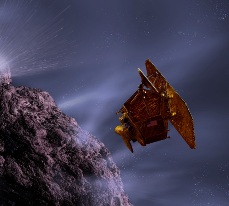EPOXI
Two intriguing investigations -- One flight-proven spacecraft
News: UM Proposal for Deep Impact Extended Mission Clears Major Hurdle, 2006.10.30
Press Release
UM Proposal for Deep Impact Extended Mission Clears Major Hurdle2006.10.30
A University of Maryland proposal to send the Deep Impact spacecraft on an extended mission to get a close-up look at Comet Boethin has cleared the biggest step in a two-step NASA approval process.

On October 30 the space agency announced that two proposals to use the Deep Impact's flyby spacecraft for new missions were among the three "missions of opportunity" proposals chosen to provide detailed concept studies that NASA will use in the final selection process.
The proposed Deep Impact follow-on missions are called DIXI and EPOCh. The Maryland-led Deep Impact Extended Investigation (DIXI) seeks to use the surviving Deep Impact spacecraft and its three working instruments (two color cameras and an IR spectrometer) for an extended flyby of Comet Boethin. The Extrasolar Planet Observations and Characterization (EPOCh) mission would use the high resolution camera on the Deep Impact flyby craft to search for Earth-sized planets around other stars.
Mission DIXI
The University of Maryland-led team that produced the spectacular Deep Impact mission, which smashed an impactor into Comet Tempel 1 in July, 2005, hopes new information gathered from Comet Boethin will help coalesce the vast array of new cometary information into solid ideas about the nature of comets, how they formed and evolved and if they have played a role in the emergence of life on Earth.
"As we try to interpret the larger meaning for all comets of our results from Deep Impact at Tempel 1, we have realized more and more how important is the variation from comet to comet," said Deep Impact leader and University of Maryland astronomer Michael A'Hearn.
"Deep Impact's flyby spacecraft and payload are still healthy. We propose to direct the spacecraft for a flyby of Comet Boethin in December, 2008, to investigate whether the results found at Comet Tempel 1 are unique or are also found on other comets," he said.
"This mission is a very cost effective way to provide new results that can be directly compared to the landmark Deep Impact findings as well as with the results of Deep Space 1 and Stardust and the earlier results from the numerous missions to Comet Halley."
Comet Boethin is now inbound to the sun from its most distant point that is nearly out to the orbit of Saturn, A'Hearn says. "At encounter, Comet Boethin will be just outside Earth's orbit, closer to the sun than was Tempel 1 (at the orbit of Mars) but about the same distance from Earth."
Like Deep Impact, DIXI will be a partnership between the University of Maryland, NASA's Jet Propulsion Laboratory (JPL), and Ball Aerospace & Technologies Corporation.
"One of the great surprises of comet explorations has been the wide diversity among the different cometary surfaces imaged to date," said A'Hearn, who will be principal investigator for DIXI. "Even on Tempel 1, the comet we've imaged the best, there is shocking variability in its surface. The comet's different surface types clearly have undergone different histories."
A'Hearn says the data obtained from DIXI will also will help scientists determine which characteristics of comet structure and composition are primordial, reflecting conditions and processes that existed 4.5 billion years ago when the solar system formed, and which are the result of evolutionary forces (heating and cooling, impacts, etc.) that have acted on comets since that time.
"Data from comets can help us to better understand the origin of the solar system, as well as what role, if any, comets may have played in the emergence of life on Earth," said Jessica Sunshine, a member of the Deep Impact science team, who will be deputy principal investigator on DIXI. "However, we first must know which cometary characteristics are due to evolution and which are primordial."
Deep Impact Surprises
Deep Impact was the first large scale experiment ever conducted on a comet. The Deep Impact flyby spacecraft made many surprising discoveries on approach to Comet Tempel 1. These include an extremely fluffy composition that largely insulates the interior from heat experienced by the surface; frequent, natural outbursts; major differences in the distribution of carbon dioxide and water; craters and other surprising geological features; demonstration that the ice below the surface must be evaporating (subliming) to water vapor, and the first detection of ice (a very small amount) on a cometary nucleus.
"Since half the discoveries at Tempel 1 were from the flyby data taken before impact, DIXI can return half the science of Deep Impact for much less than 10 percent of the cost of Deep Impact," A'Hearn said. "From the point of view of cost effective science, an extended mission such as DIXI is unbeatable."
Mission EPOCh
The Extrasolar Planet Observations and Characterization (EPOCh)proposal is led by Drake Deming, a former University of Maryland scientist who has been with the NASA Goddard Space Flight Center since 1980. This proposal is a collaboration between some members of the Deep Impact science team, including A'Hearn and University of Maryland research scientist Dennis Wellnitz, and a new team of scientists, led by Deming, who are experts on extra-solar planets.
Lee Tune
University of Maryland, College Park
301-405-4679
ltune [at] umd [dot] edu
Source
